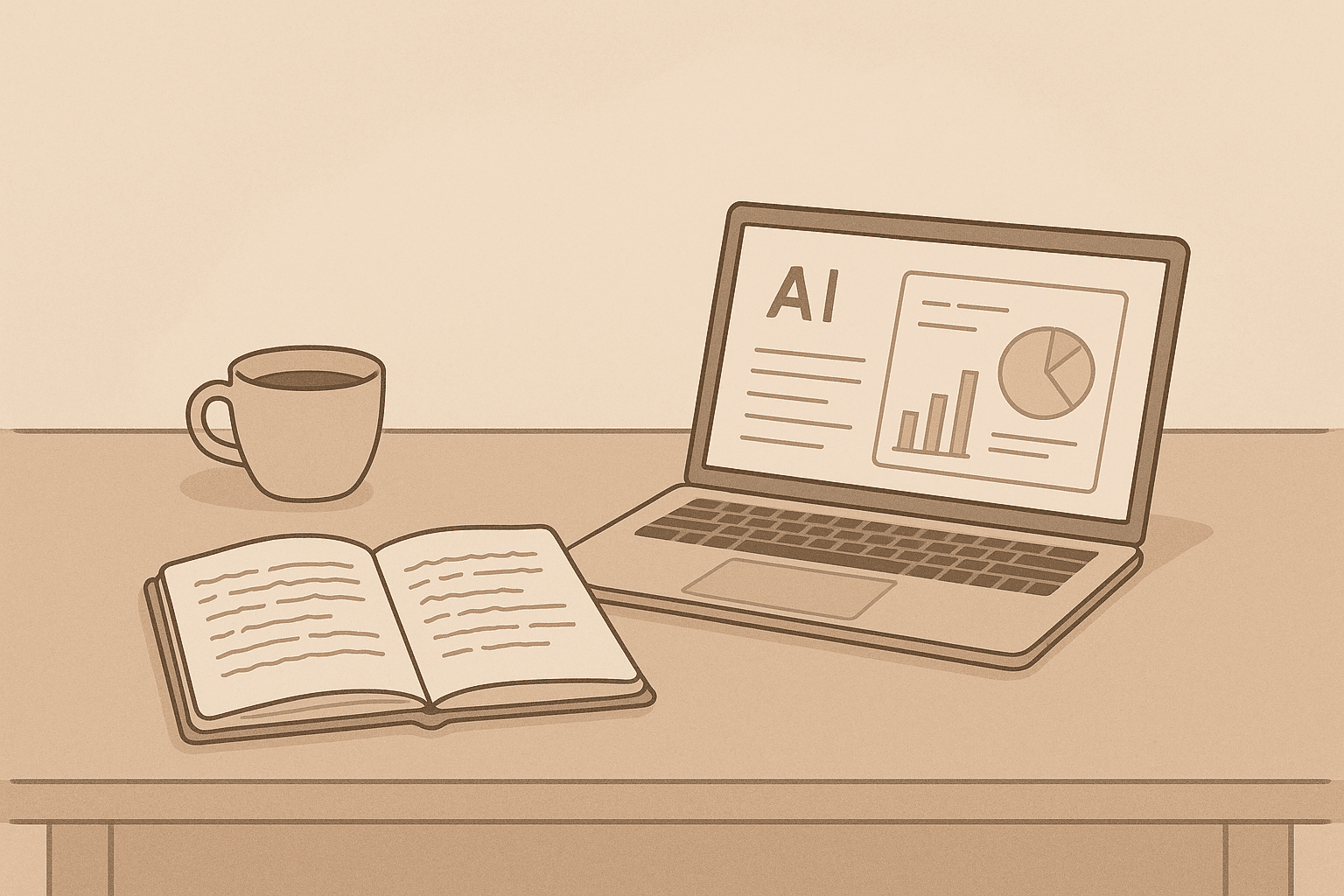
The Truth About AI Detection: Myths vs. Reality for Academic Writing
AI detection tools are reshaping academic integrity, but they're far from perfect. Here's what you need to know:
- AI detection tools have limitations: They can mislabel human-written work as AI-generated (false positives) and fail to catch sophisticated AI content.
- Accuracy varies: Tools like Turnitin and GPTZero claim low false positive rates (1–2%), but their effectiveness decreases with shorter or heavily edited texts.
- Bias concerns: Non-native English speakers are flagged more often due to writing style differences.
- Cost and accessibility: Platforms like Turnitin are expensive, limiting access for smaller institutions.
- Evolving AI models: Detection tools struggle to keep up with rapidly advancing AI writing technologies.
Quick Takeaway
AI detection tools are helpful but flawed. They should supplement, not replace, human judgment when evaluating academic work. Institutions must balance technology with clear policies and education on ethical AI use.
This AI Detector Has a 96% Accuracy Rate... But Can You Trust It?
1. Yomu AI
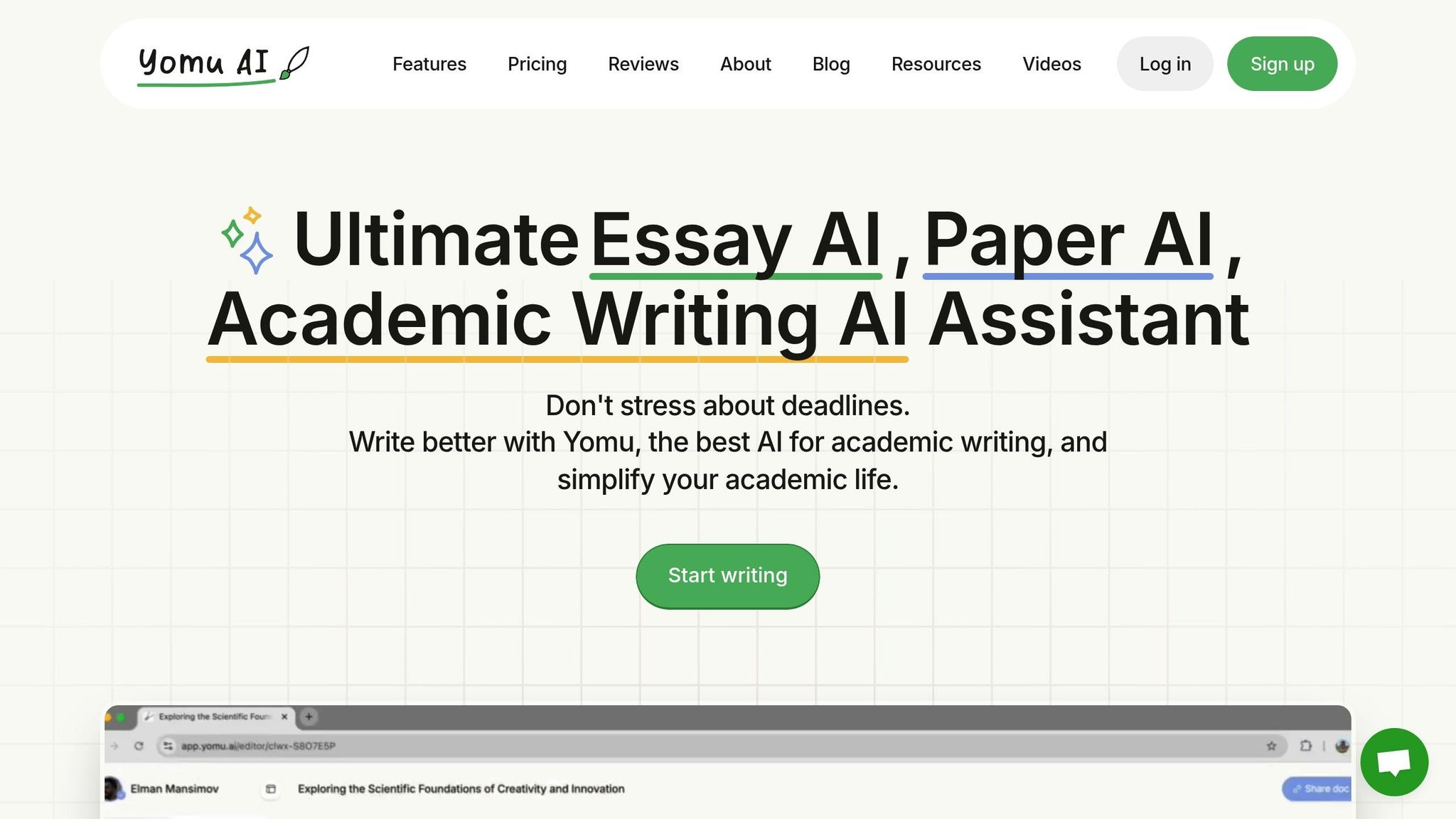
Yomu AI is a writing assistant tailored specifically for academic needs. It offers tools to assist with document creation and includes a plagiarism checker to help students maintain originality and proper citation in their work.
Detection Accuracy
With its built-in plagiarism checker, Yomu AI helps uphold academic integrity. However, it does not have the capability to detect AI-generated text.
Academic Tools and Features
Yomu AI combines writing support with essential academic tools. It offers features like autocomplete, paraphrasing, summarization, and a citation tool that simplifies formatting for widely used U.S. academic styles. This all-in-one approach streamlines the process of writing, editing, and verifying originality for essays and research papers. Up next, we’ll look at Turnitin to see how its features compare.
2. Turnitin
Turnitin is a well-known name in U.S. higher education. While it originally served as a plagiarism checker, it has evolved to include features like detecting AI-generated content. Let’s explore how it performs and integrates into academic workflows.
Detection Accuracy
Turnitin’s plagiarism detection works by comparing submitted work against an extensive database of academic sources, web content, and prior student submissions. In April 2023, Turnitin added an AI writing detection feature. This tool aims to flag sections of text that might have been created by artificial intelligence. However, its accuracy can vary, especially with shorter text passages or heavily edited content.
Report Details
Turnitin generates similarity reports that highlight text matching existing sources. Each highlighted section links directly to its source, whether it’s a website, a published paper, or another student’s work. The report also provides a similarity percentage, showing how much of the text overlaps with existing material. For AI detection, the system includes an indicator that signals the potential use of AI-generated content.
Integration with Academic Workflows
Turnitin seamlessly integrates with popular learning management systems like Canvas, Blackboard, and Moodle. This setup allows educators to access plagiarism reports directly within their grading platforms. The system also supports batch processing, making it easier to handle multiple submissions at once. In many cases, students can view their similarity reports before submitting their final work, giving them a chance to fix citation or paraphrasing issues.
Language and Text-Type Support
Turnitin supports over 30 languages and accepts various file formats, including Word, PDF, and plain text. It’s designed to handle a wide range of academic writing, from research papers to creative assignments. The tool recognizes properly formatted citations, helping to differentiate between legitimate quotes and potential plagiarism. However, manual review is still crucial to determine whether flagged text constitutes academic misconduct or aligns with scholarly standards.
3. GPTZero
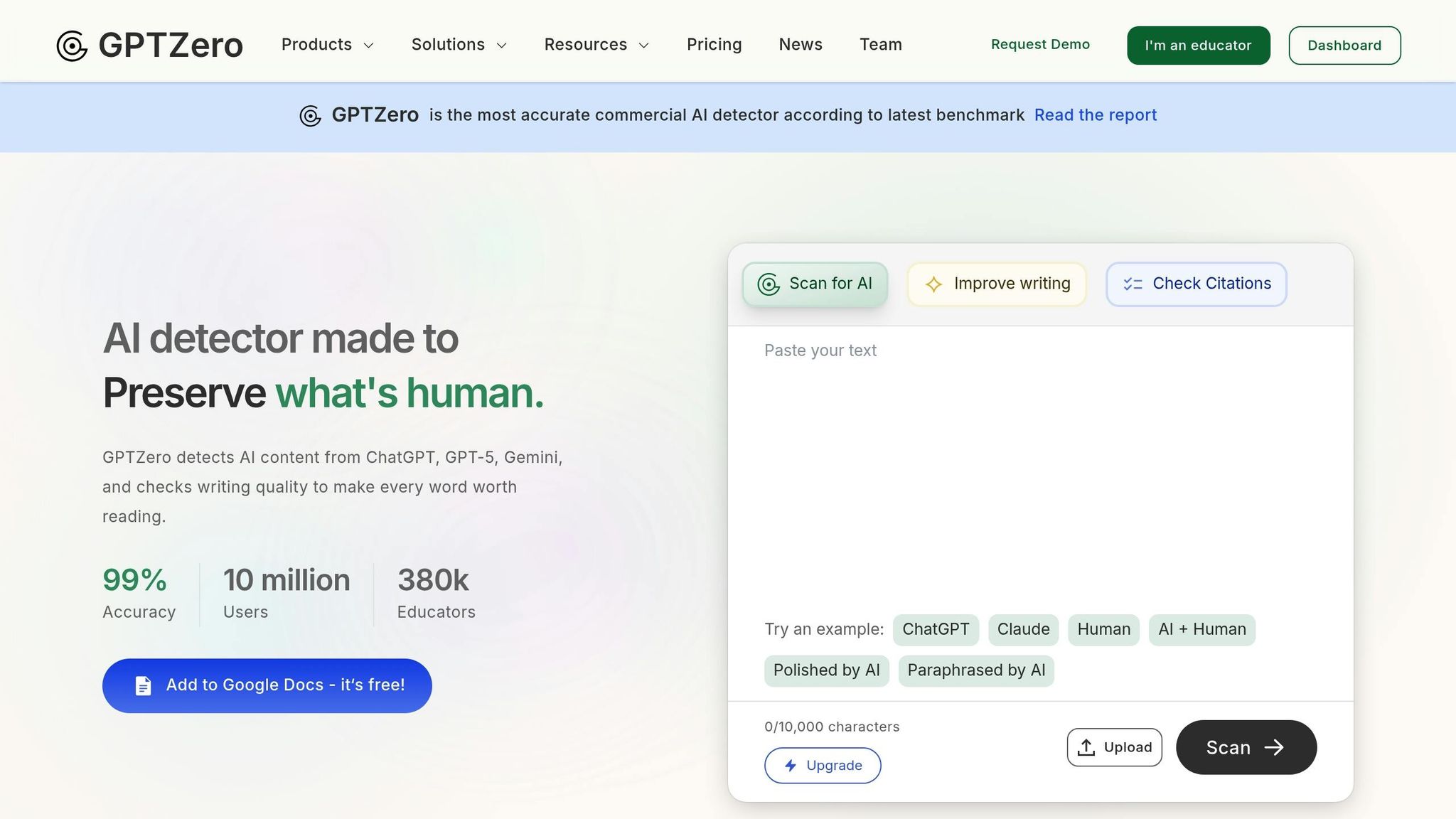
GPTZero stands out as a tool specifically designed to detect AI-generated content, rather than focusing on plagiarism. Launched in January 2023 by Edward Tian, it quickly gained attention in academic circles for its ability to identify text created by AI models like ChatGPT and others.
Detection Accuracy
GPTZero uses two key metrics to analyze text: perplexity and burstiness. Perplexity assesses how predictable the text is, while burstiness looks at variations in sentence structure. Human writing typically shows more variety and complexity, whereas AI-generated text tends to be more uniform and predictable.
The tool works best with longer text passages, requiring at least 250 characters for accurate results. However, it struggles when analyzing content that mixes human and AI-generated text or has undergone significant editing. To make its findings clear, GPTZero provides reports with visual breakdowns.
Report Details
The analysis reports from GPTZero are simple and easy to follow, using color-coded highlights to differentiate content. Green sections point to likely human-written text, while red sections suggest AI involvement. Each report also includes an overall probability score, ranging from 0% to 100%, indicating how likely it is that the entire document was AI-generated.
Although the tool flags specific sentences, it doesn’t explain why certain sections are marked as AI-generated. This lack of explanation can limit its usefulness for educators who need deeper insights. Still, its user-friendly reports and interface make it a practical option for many.
Integration with Academic Workflows
GPTZero offers a web-based platform where users can input text directly or upload files for analysis. For those managing large volumes of work, premium plans allow batch processing of multiple submissions. However, the tool's integration capabilities are somewhat limited - it doesn’t connect directly with popular learning management systems like Canvas or Blackboard.
For institutions with technical resources, GPTZero provides API access, enabling its integration into custom workflows. That said, this option requires advanced technical know-how, which may not be feasible for smaller institutions or individual educators.
Language and Text-Type Support
GPTZero primarily focuses on analyzing English text and performs best with academic or formal writing styles, as its training data emphasizes these formats. It’s less reliable when handling creative writing, technical documents, or informal content.
Additionally, the tool may struggle with formatting elements like tables, images, or complex layouts, which can interfere with its analysis. These limitations highlight where GPTZero fits within the broader effort to maintain academic integrity in writing.
sbb-itb-1831901
4. Copyleaks
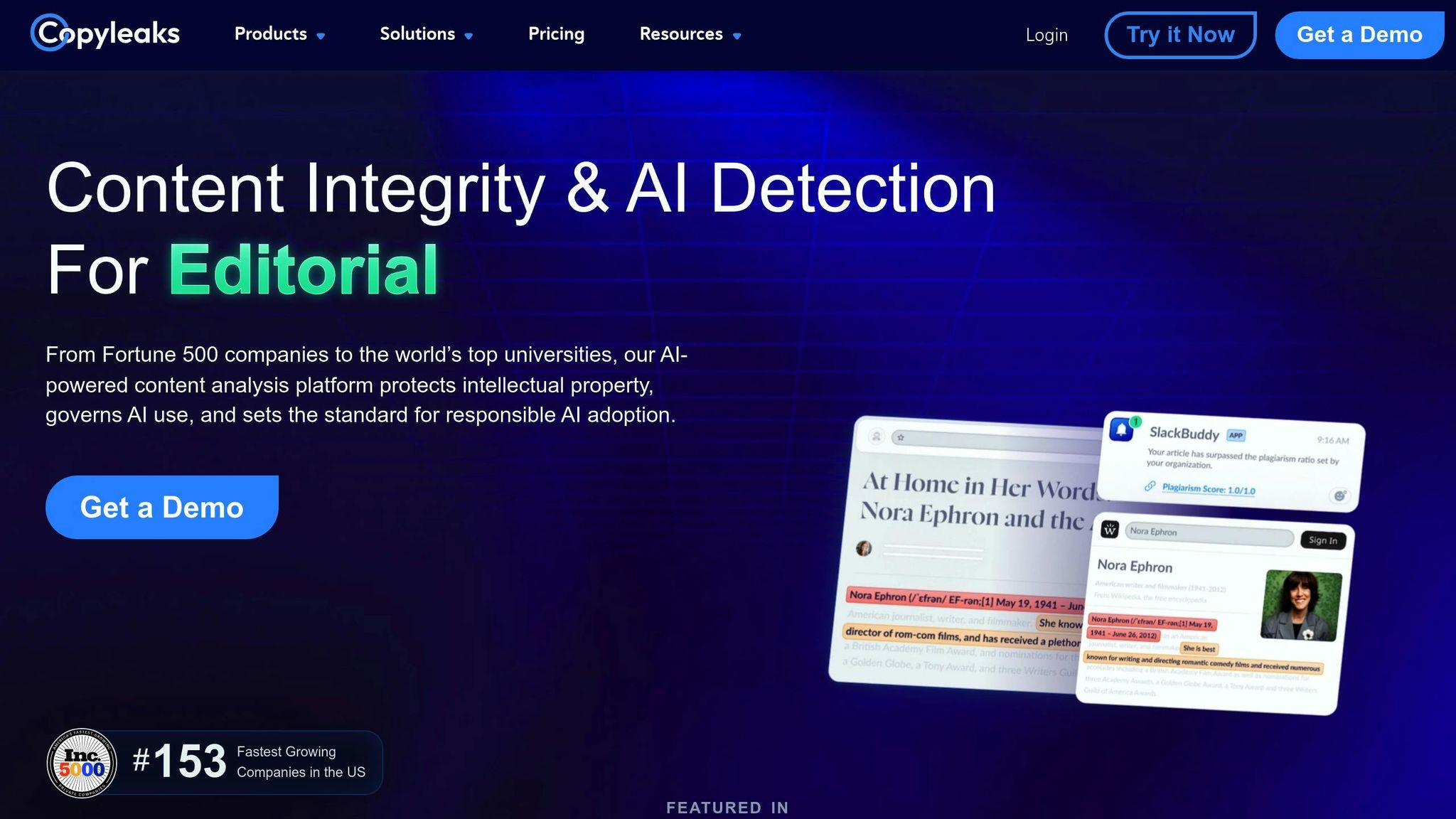
Copyleaks is a platform designed to ensure content authenticity by combining plagiarism detection with AI content analysis. Unlike tools that focus on just one aspect, it offers a comprehensive solution for verifying the originality of written material.
Detection Accuracy
Copyleaks uses an advanced approach to identify AI-generated content by analyzing writing patterns, sentence structures, and language usage. It works effectively for documents over 500 words but tends to struggle with texts that are heavily edited or combine human and AI-generated content.
The tool assigns confidence scores to its detections, though these can vary depending on the subject matter and writing style. For instance, its focus on formal language may lead to false positives in technical or specialized fields. These findings are summarized in detailed reports.
Report Details
The platform generates reports with paragraph-specific highlights, using color coding to indicate detection confidence - yellow for moderate and red for high. It also offers side-by-side comparisons of the original and analyzed text, making it easier to evaluate flagged sections. Each report includes a percentage score reflecting the likelihood of AI involvement in the document.
For added convenience, reports can be exported as PDFs, making them easy to store or share.
Integration with Academic Workflows
Copyleaks is built to integrate smoothly into U.S. academic systems. It connects directly with popular learning management systems like Canvas, Blackboard, and Moodle, allowing instructors to analyze student submissions without leaving their workflow.
The platform supports both single-document analysis and batch processing, enabling educators to review multiple assignments at once. For institutions managing a high volume of content, Copyleaks provides API access for custom integrations with their existing systems.
Premium accounts for institutions include features like user management tools, analytics dashboards, and customizable reports, making it a practical choice for larger schools or universities that need to monitor AI usage across various departments.
Language and Text-Type Support
Copyleaks supports content analysis in over 30 languages, making it accessible to users around the globe. That said, its accuracy is generally strongest when analyzing English-language texts.
The platform is compatible with various file types, including Word documents, PDFs, and plain text files, and can handle documents with complex formatting. However, elements like tables, charts, and images may impact the results.
Copyleaks excels in analyzing standard academic formats like essays, research papers, and reports. However, it’s less reliable when working with creative writing, poetry, or highly technical documents, where unique styles or specialized terms can confuse its algorithms.
5. QuillBot
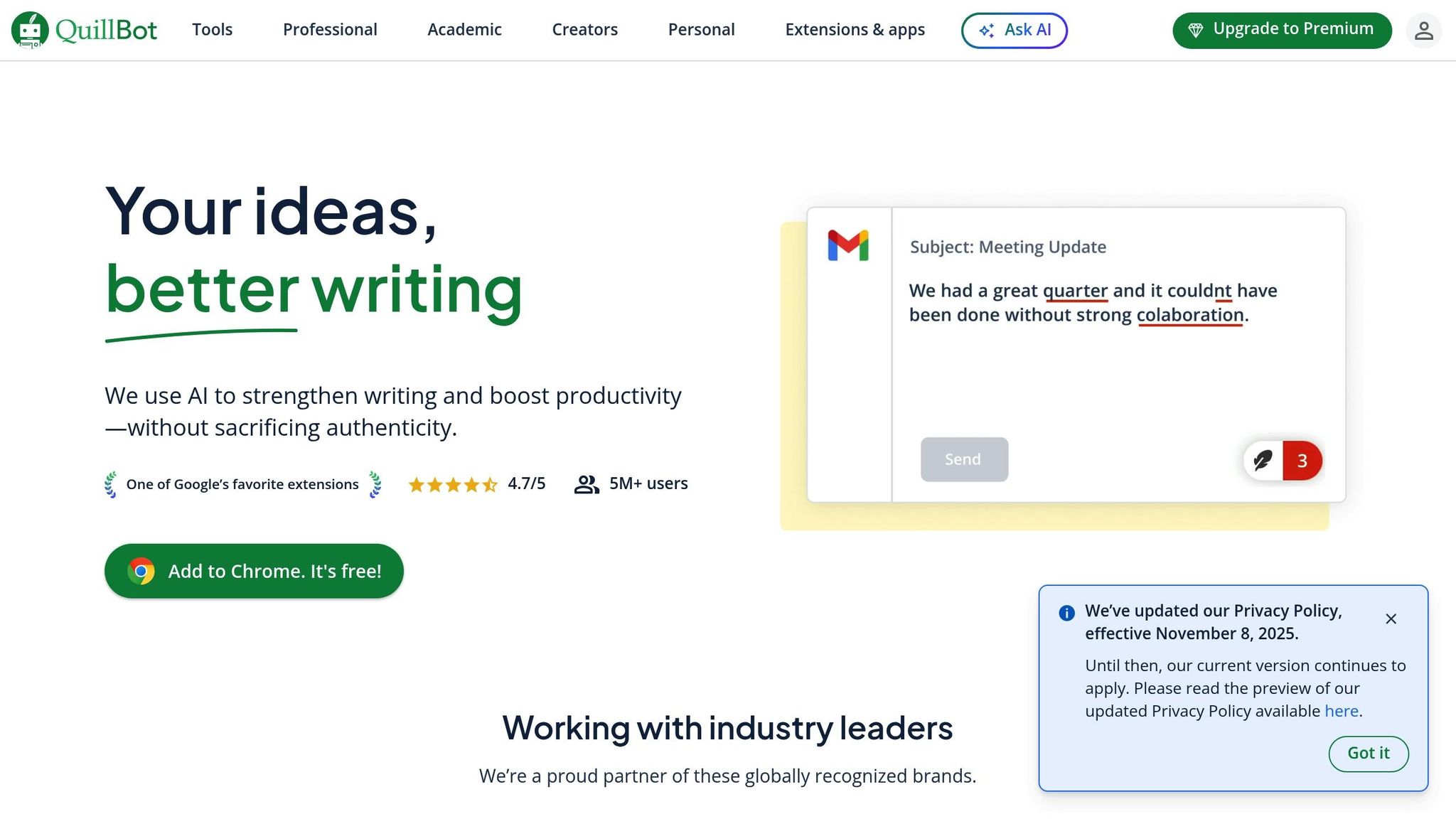
QuillBot takes a unique angle on content editing and plagiarism detection, especially in academic writing. Initially built as a paraphrasing and writing tool, it now includes plagiarism detection features. However, it doesn't specifically focus on identifying AI-generated content.
Detection Accuracy
QuillBot's plagiarism checker works by comparing submitted text against a wide range of web sources and academic databases. Its strength lies in spotting copied content, but it falls short when it comes to identifying AI-generated material. The tool's effectiveness largely depends on the breadth of its database and performs best when dealing with direct or closely matching text.
Report Details
The plagiarism reports from QuillBot are simple and easy to follow. Problematic sections are marked in red, with each flagged passage showing a percentage match and a link to the original source. Users also get an overall similarity score and the ability to review matches one by one. That said, these reports lack the detailed visuals and in-depth analysis provided by more specialized tools.
Integration with Academic Workflows
QuillBot functions mainly as a web-based platform and has limited integration options. While it does offer browser extensions and API access, it doesn’t directly connect with popular learning management systems like Canvas or Blackboard. This makes it a better fit for individual users rather than large-scale institutional use.
Language and Text-Type Support
The tool supports multiple languages and accepts various text formats, whether through direct input or document uploads. It handles standard academic writing well but may struggle with highly technical documents or niche terminology. Its paraphrasing capabilities shine when working with formal English, making it particularly useful for academic writing in the U.S.
This breakdown of QuillBot highlights how it balances basic functionality with ease of use, while also pointing out its limitations in addressing the growing role of AI in academic integrity challenges.
Advantages and Disadvantages
As academic institutions work to uphold integrity, it's crucial to understand the strengths and weaknesses of AI detection tools. Each tool brings its own benefits and challenges, and evaluating these trade-offs helps institutions make informed decisions about their integration.
The table below compares key aspects of popular AI detection tools, highlighting factors like accuracy, bias, and usability.
| Tool | Detection Accuracy | Report Quality | Workflow Integration | Language Support | Key Advantages | Major Disadvantages |
|---|---|---|---|---|---|---|
| Yomu AI | Focuses on plagiarism rather than standalone AI detection | Provides actionable plagiarism reports | Designed for academic writing workflows | Strong English support, multilingual capability | Comprehensive academic writing support | Lacks robust AI content detection capabilities |
| Turnitin | Claims <1% false positive rate but misses ~15% of AI-generated content | Delivers detailed, institution-focused reports | Deep LMS integration for seamless use | Extensive multilingual database | Trusted by institutions, broad reference database | High cost, risk of wrongful flagging |
| GPTZero | Reports 1–2% false positive rate in controlled testing | Provides basic result outputs | Limited institutional system integration | Primarily supports English | Accessible detection metrics | Struggles with diverse text styles |
| Copyleaks | Exhibits 1–2% false positive rate in testing | Produces detailed analytical reports | API integration for enterprise use | Supports multiple languages | Tailored for enterprise-level needs | Limited adoption in academic settings |
| QuillBot | Primarily designed for plagiarism detection | Offers straightforward similarity reports | Web-based tool for individual users | Good formal English support | Known for paraphrasing and text enhancement features | Not optimized for detecting AI-generated content |
Key Challenges
Reliability
Reliability is a significant hurdle for AI detection tools. Even industry leaders face challenges - OpenAI, for instance, discontinued its own AI detection software due to poor accuracy. A 1% misflag rate may seem low, but in practice, it could wrongly label thousands of students, leading to academic penalties, strained relationships with educators, and undue stress.
Bias
Bias is another pressing issue. Many AI detectors rely on standardized linguistic patterns, which can unfairly target non-native English speakers. Research shows that these tools often flag their work at higher rates, penalizing students whose writing styles differ from conventional norms.
Cost
The financial burden of these tools can be prohibitive. For example, Turnitin's enterprise solutions are expensive, and iThenticate charges $100 for manuscripts under 25,000 words. This creates access barriers for smaller institutions and independent researchers.
Evolving AI Models
The rapid advancement of AI writing tools poses another challenge. Detection technologies often lag behind, struggling to keep up with the capabilities of newer AI models. This constant game of catch-up makes long-term reliability uncertain.
Integration
Integration capabilities vary widely. Turnitin excels with its deep LMS compatibility, making it ideal for large institutions. On the other hand, tools like QuillBot cater more to individual users, while Yomu AI focuses on supporting the entire academic writing process rather than just AI detection.
High Error Rates
A study on behavioral health publications revealed that one free AI detector misidentified a median of 27.2% of legitimate academic text as AI-generated. Such high error rates have led many institutions to approach these tools with caution or advise against over-reliance on them.
While these tools offer valuable support, their limitations highlight the importance of a balanced approach. Combining technology with human judgment remains essential for maintaining academic standards.
Conclusion
AI detection in academic writing is a challenging and evolving field. While these tools aim to support academic integrity, they often fall short of expectations in practice.
The Current State of Detection Technology
Detection tools frequently struggle with accuracy, highlighting the need for ongoing improvements. These shortcomings also raise broader questions about fairness and reliability in their application.
Concerns About Fairness and Accessibility
One persistent issue is whether these tools can fairly evaluate the wide range of academic writing styles. Many users question their ability to consistently assess diverse forms of expression, which can lead to unintended biases in their evaluations.
A Balanced Approach to Implementation
For academic institutions, the key lies in using AI detection tools as a supplement rather than a final authority. These tools work best when paired with human oversight, allowing educators to interpret results critically. This approach ensures that detection scores are not treated as definitive evidence of misconduct but rather as one piece of a larger puzzle. Institutions should adapt their use of these tools to meet their unique needs and priorities.
Yomu AI offers advanced plagiarism detection and writing assistance to streamline academic processes. However, the success of such tools depends not just on their implementation but also on thoughtful policies that guide their use.
Moving Forward Responsibly
As AI writing tools continue to advance, academic institutions must focus on educating students about ethical AI use, establishing clear guidelines for acceptable assistance, and openly communicating the limitations of detection tools. The most effective strategy combines technology with human judgment, ensuring a balanced and fair approach to academic integrity.
FAQs
How do AI detection tools affect non-native English speakers in academic writing?
AI detection tools can occasionally pose problems for non-native English speakers, often mistaking their unique writing styles for AI-generated content. This happens because these tools may fail to differentiate between natural language variations and patterns that mimic AI output.
The result? Unwarranted claims of academic dishonesty. For students, this can be both stressful and unjust. To address this, educators and institutions need to recognize the limitations of these tools. Instead of relying on them exclusively, they should incorporate them into a more comprehensive evaluation process - one that ensures fairness and equity for every student.
What are the key challenges of using AI detection tools to uphold academic integrity?
AI detection tools encounter several hurdles in upholding academic integrity. A significant challenge is accuracy - these tools sometimes misidentify human-written work as AI-generated (false positives) or miss AI-generated content entirely (false negatives). Such inconsistencies can cast doubt on their dependability.
Another obstacle is bias. Some tools may disproportionately flag content written by non-native English speakers due to differences in writing styles or linguistic nuances. On top of that, students can often outsmart these systems by rephrasing AI-generated text or employing other clever tactics, which makes it harder for the tools to remain effective.
Though these tools have their place, being aware of their shortcomings is crucial for using them responsibly in academic environments.
Why should academic institutions use both AI detection tools and human judgment when reviewing academic work?
AI detection tools can play a role in spotting potential AI-generated content, but they aren't foolproof. These tools can sometimes flag content incorrectly, leading to false positives that might unfairly label students as violating academic rules. Leaning entirely on these tools can strain the trust between educators and students.
A better approach combines AI detection with human judgment. Human reviewers add critical thinking and context, helping to avoid errors and ensuring decisions are made thoughtfully. This blend not only upholds academic integrity but also promotes fairness in the learning environment.
